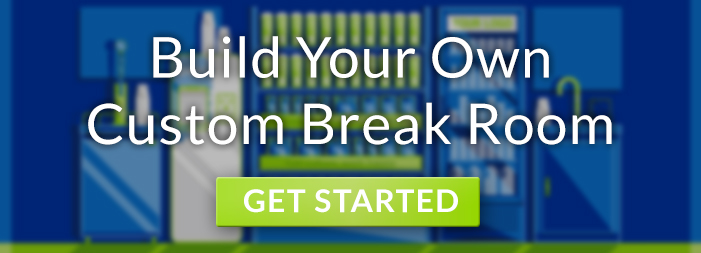A positive company culture provides an edge. Companies with superior culture are likely to enjoy happier employees who stay longer—and work more productively, creatively and collaboratively during their time at the organization.
In fact, your company’s culture is closely tied to your company’s value—50 percent of today’s executives say that culture is a top-three driver of brand value and 84 percent believe poor culture is a liability and can lead to risky behavior by employees.
While culture is a complex mixture of factors, don’t underestimate the importance of a communal space for your employees to take a few minutes to refresh, have fun and build relationships with their colleagues.
A break room is more than just space for your employees to grab a cup of coffee or nitro cold brew—though research reveals that hot or cold caffeine does provide a boost in performance, creativity and your employees feeling valued.
There’s a reason that the Googles and Facebooks of the world invest heavily in epic break rooms and break room culture. It supports a collaborative, happy culture that translates into better retention, recruitment and performance.
Fortunately, great break room design doesn’t have to be expensive. As Inc.’s Jason DeMers highlights, you just need the right essentials and a little personalization.
5 Must-Have Features in a Break Room
While you’ve probably heard rumors of tech firms with adult-sized playground equipment, it isn’t strictly necessary. If you strip your break room down to the top five features and attributes, what would they be? Research reveals that employees may need five things to enjoy their dedicated break space.
1. Caffeine and Healthy Snacks
Everyone needs coffee and everyone needs to eat. By providing access to these fundamentals on-site, free of cost, you’re saving your employees a trip to the coffee shop and showing that you value them.
Providing higher-quality options can also yield an edge, even though some people may suffer through a cup of low-quality roast coffee with powdered creamer in it.
Office healthy snacks can help your employees avoid the inevitable energy crash associated with sugary treats. By providing amazing local cold brew coffee, low-fat cookies, pretzel nuggets and other delicious options, you can communicate that you care.
2. Decor & Comfortable Seating
Comfortable lunch tables provide space for your employees to enjoy a meal or engage in impromptu ideation sessions, but your seating should also accommodate true relaxation. Employees can’t take a comfortable 15-minute siesta in a hard plastic chair.
DeMers recommends home-like chairs and couches, noting that the cost bump in better furniture is a long-term investment in your break room culture.
3. Simplicity & Organization
Lighting, furniture, art, and how kitchen items are arranged and displayed all play a major role in how your break room “feels.” No one wants to hang out in a space filled with dirty dishes, 90s motivational posters or other types of visual clutter.
In the healthcare industry, having an amazing break room can also be a key factor in protecting patient safety. Stressed, overtired nurses may be more likely to make critical mistakes. That’s why simplicity was a driving factor in a research-driven break room design project by Spectrum Health.
Spectrum achieved visual simplicity and enhanced the relaxation factor by deciding to “to drastically reduce the amount of visual clutter in the break rooms… relocate bulletin boards and remove personal items from locker fronts.” After the redesign project was complete, employee perception of their organization and culture improved significantly.
4. Employee Involvement
Your employees likely have the best understanding of what your break room needs. This can vary drastically between organizations—Camelback, the outdoor gear manufacturer, offers showers for their sweaty, outdoorsy staffers.
Mindbody, a fitness app, gives people access to massage and fitness classes. By surveying your employees during a break room design initiative, you can increase satisfaction and make sure you’ve got the right features in place.
5. Space Optimization
Even if your organization’s existing break room is a tiny, dingy little room, you’re not out of luck. Space optimization is a key feature of break room design and it’s possible to achieve the right flow of furniture and fixtures, natural-feel lighting and the illusion of spaciousness.
Entrepreneur writes that two organizations with truly epic break rooms, Conversant and Rightpoint, opted for furniture built into the hallways or cafe-style nooks to make the most of the tight square footage.
Unique Ways to Customize Break Room Design
While there’s no shortage of amazing, inspiring tales of companies who’ve completely rocked their break room design, we’ve collected insight into a few you’ll love. The following mini-case studies illustrate that a break room design project doesn’t need a multi-million dollar budget to have a huge impact.
1. Tris3ct
Ideas are everything in the advertising space—which is why this Chicago-based agency has break room walls made out of whiteboard, chalkboard and corkboard to support all kinds of ideation.
2. Bain & Company
While there’s nothing that unusual about the break room at globally renowned consulting firm Bain & Company, all hallways lead straight to the beloved communal space that offers espresso and a pool table.
3. Sparks
Health and food are huge factors at this Philadelphia marketing firm. In addition to regular healthy snack offerings, there’s room in the budget for a once-per-month catered meal featuring farm-to-table gourmet dining.
Drink Coffee, Take an Enjoyable Break
Corporate Essentials has more than two decades of experience in innovative, effective break room design projects that leverage key principles of customization, functionality and style.
Armed with research and firsthand knowledge, our specialists help organizations transform even the most challenging spaces into relaxing, refreshing respites for their staff members.






